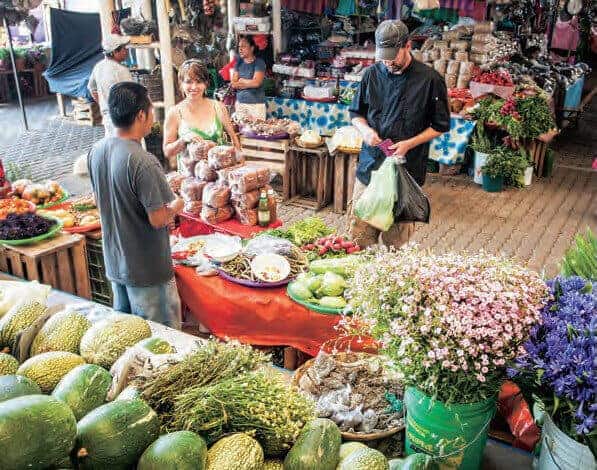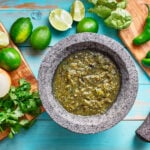We may earn income from links in this post. Please read this Disclosure for details.
This easy recipe for salsa verde Mexicana — green tomatillo salsa — has a fabulous fresh flavour that will add zip to grilled meats, tortilla wraps or even scrambled eggs.
For the best flavour and texture, make it in a molcajete, the Mexican version of a mortar and pestle!

Ideally suited for small batches, salsa verde Mexicana is best made in a molcajete and served immediately.
However, if you have a bounty of fresh tomatillos and tomatoes and are looking for a recipe that uses up a large quantity of the two and is freezer-friendly, then check out my recipe for Freezer Tomato and Tomatillo Salsa.
The Mexykan Private Chef Services in Puerto Escondido
This recipe has been provided by Chef Tony aka The Mexykan in Puerto Escondido. I first tried his version of this popular Mexican salsa when he served it at as an appetizer at a friend’s villa on a beautiful stretch of beach outside of town.
While we sipped margaritas and snacked on salsa verde and home-made tortilla chips, a technicolour sun set on the Pacific Ocean.
It was one of those evenings where you were convinced there was no place more beautiful in the world.

I’m thrilled he agreed to share his recipe straight from The Mexykan kitchen with A Taste for Travel readers.
Salsa Verde Mexicana from Puerto Escondido Oaxaca
This recipe for Salsa Verde Mexicana is actually one of the recipes featured in Tony’s popular Traditional Mexican Salsa Cooking Demonstration Class, offered in Puerto Escondido.
Learning about traditional Oaxacan food is a top thing to do in Puerto Escondido, Oaxaca City and Huatulco. There’s no better way to soak up some local culture and master some new skills than by taking a cooking class.
His version of salsa verde features tomatillos (also known as miltomates), onion, garlic and chile and is easy to whip up for your next party or gathering.
You can also use salsa verde as a topping for chicken, chilaquiles, Guatemalan black beans and rice or tacos. It’s a versatile salsa that’s a staple in Mexican cooking.

Key Ingredients for Salsa Verde

Fresh tomatillos are the most important ingredient in an authentic salsa verde. Also known as the Mexican Husk Tomato, a miltomate and a tomate verde, this round green fruit is packed with nutrition and flavour.
A member of the nightshade family, tomatillos grow on small plants and each of the round fruits is wrapped in a papery husk which MUST be removed prior to eating.
The tomatillos in the photo above still have their husks on them. Some of the tomatillos below have had their husks (also known as lanterns) removed so you can see the difference.
Are Tomatillo Plants Poisonous?
Because the husk (lantern), leaves, and stems of the tomatillo plant are toxic, after husking a tomatillo be sure to wash your tomatillos thoroughly. That will remove the sticky substance on the fruit.
You might also want to wear gloves if you don’t want the stickiness to get on your hands. But don’t worry if you do.
Although it’s annoying, the sticky residue on tomatillos isn’t dangerous. It’s actually a substance known as withanolides, a naturally occurring chemical compound found within the family of nightshade plants.

In fact, scientists believe the sticky substance may act as a deterrent for feeding insects while the fruit is ripening. That’s a good thing.
What is the Flavour of a Tomatillo?
What does a tomatillo taste like? Tomatillos are tart, acidic and slightly herbal in taste. The riper they get, the less acidic they taste.
When shopping for tomatillos in the market, look for fruit with loose lanterns. The husk should be puffy and have pulled away from the fruit. The husk should be easy to peel off.
When fresh, the fruit of a ripe tomatillo is dark green rather than white. They remain firm when ripe and don’t soften as quickly as tomatoes. They also store remarkably well — up to three weeks in a cool area.
If you have tomatillos left over, check out our traditional Guatemalan recipe for Jocon de Pollo – Chicken in Green Sauce.
Making Salsa Verde Mexicana in a Molcajete
Versatile with just the right amount of kick, salsa verde is a staple in every Mexican kitchen. It’s usually made in a molcajete, the Mexican version of a mortar and pestle.
The molcajete refers to the three-legged round bowl while the pestle is known as the tejolote. Both are carved out of basalt volcanic rock.
The advantage of using this traditional tool made of volcanic stone, is that it grinds the vegetables without the heat that is generated by a mechanical blender. The flavours of the ingredients are preserved and not burnt or over-processed.

If you purchase an authentic Mexican molcajete, note that you need to season it before using. Otherwise, you’ll get volcanic grit in your salsa and the molcajete will be very hard to clean in the future.
When I purchased mine, the vendor told me to follow these steps in curing a molcajete and tejolote:
- Wash the molcajete with water, scrub with a clean brush and dry throughly.
- Fill the molcajete one quarter full with dry white rice (or dried maize corn).
- Hold the tejolate (or pestle) in one hand with the large side down and the bowl in the other. Use a circular motion to press down on the rice in a grinding motion.
- Continue grinding the rice up and down the interior of the bowl of the molcajete until it forms a powder. Be sure to work the rice into the tiny holes in the volcanic stone and along the upper lip while grinding.
- Discard the rice powder and repeat the process with the rice twice, discarding the powder each time.
- Add two tablespoons of sea salt to another batch of white rice and repeat the process. The powder should now be white not grey in colour. If it isn’t, then repeat the process of adding and grinding the rice until it is.
- Rinse the molcajete out with water. It’s now ready to use!
As you use your molcajete to make salsas and guacamole, it will improve with age, adding a depth of flavour to your salsas much like an heirloom cast iron pan does.
Just remember not to use harsh soap on it or put it in the dishwasher.
How to Serve Salsa Verde
This salsa verde is fantastic for topping on chilaquiles, grilled chicken, Guatemalan black beans and rice or tacos.
It also mades a great dipping salsa for tortilla chips. I also enjoy serving salsa verde at breakfast alongside tortitas de berro – Guatemalan watercress fritters or on huevos divorciados, a classic Mexican breakfast dish served with red and green salsa.
Store salsa verde in the refrigerator for up to three days.
If you try this recipe, please rate it and share your comments or photos by tagging us at #atastefortravel. We’d love to see your photos!
Another tomatillo recipe you might enjoy is Jocon – a traditional Mayan dish popular in the highlands of Guatemala. It also features tomatillos and is absolutely delicious!
Salsa Verde (Green Tomatillo Salsa)
Equipment
- Blender or Molcajete ( Mexican mortar and pestle)
Ingredients
- 1.5 cups tomatillos or miltomate husked, cleaned and rinsed
- 1/4 cup white onion chopped
- 3 stalks cilantro roughly chopped
- 1 chile tusta or serrano 4 or to taste whole, stems removed (or chile serrano)
- 1 clove garlic whole
- 1/2 teaspoon salt to taste
Instructions
- Cover tomatillos, chiles and garlic with just enough water to cover in a small sauce pan.
- Simmer until the tomatillos start to turn a drab olive colour. Be sure not to overcook. They should be soft but not mushy.
- Let cool for a few minutes.
- Strain the ingredients reserving the water.
- Place the salt, tomatillos, peeled garlic, cilantro and chiles into a blender jar, food processor or molcajete (Mexican mortar and pestle).
- Blend to a rough textured sauce, add reserved water as needed.
- Garnish with chopped white onion.
- Salt to taste .
Notes
- Don't overcook the tomatillos! They should still have a bright green colour
- The amount of hot chile you use depends on your heat tolerance. Start by adding just one and work up from there.
- If the salsa verde is excessively tart to your taste, try adding a small amount -- up to 1/2 teaspoon - of white sugar.
- Yield 1 cup
Nutrition
The Mexykan Cooking Class, Market Tours and Private Classes
Fun Fact: Curious about where the name for “The Mexykan” kitchen comes from and why it isn’t “The Mexican” Cooking Class? Chef Tony grew up in southwest Kansas. This part of Kansas was in Mexico until the conclusion of the Mexican-American War in 1848. The name of his kitchen is a hybrid of Mexico Y Kansas aka The Mexykan.
This fun demonstration cooking class includes:
1. Watch, learn the techniques and taste six traditional Mexican salsas prepared by a trained chef.
2. Participate in a “Roll Your Own Taco Party” featuring six traditional Mexican salsas such as this salsa verde.
3. Enjoy fresh guacamole, corn chips, Oaxacan black beans and classic Mexican red rice.
4. Indulge in complimentary, refreshing Margaritas or ice-cold Mexican beer.
5. Sample a rare small-batch mezcal tobalá
6. Sip unlimited ice-cold Mexican agua fresca (fresh fruit water).
7. Cool off with a frozen Mexican nieve, ice or granita
8. Get a printed copy of all of the Mexican Salsa recipes.
If you’d like to register for the class in Puerto Escondido, please visit WWW.THEMEXYKAN.COM for reservations or visit The Mexykan Facebook page
Sign up for the A Taste for Travel newsletter below and you’ll even receive a free gift at the class. You can also register by email: chef at TheMexykan.com

Dividing her time between Canada, Guatemala and Mexico (or the nearest tropical beach), Michele Peterson is the founder of A Taste for Travel. Her award-winning travel and food writing has appeared in Lonely Planet’s cookbook Mexico: From the Source, National Geographic Traveler, Fodor’s and 100+ other publications.
Read more about Michele Peterson.



 Xpu-Ha Beach: A Perfect Day Trip on Riviera Maya
Xpu-Ha Beach: A Perfect Day Trip on Riviera Maya
Rebecca | Our Streamlined Life
This looks delicious! I’m super hungry now 🙂
Amanda Williams
Looks delicious – thanks for sharing.
Lara Dunning
I LOVE verde salsa!! Thanks for sharing. Food is such a great way to experience other cultures.
Brittany Quaglieri | Transformed Thru Travel
I’m trying this recipe ASAP!
Lee from EatTravelCook.com
Michele, what timing you have! I make several types of salsa myself, including tomatillo very similar to this recipe. Been making salsa for years, way before most people in the US even knew what a taco was! I have been craving REAL Mexican food for several weeks now and have this week made up my mind to get to Mexico for a few weeks this winter. I’m like you: I travel for the food. Where in Mexico do you recommend I not miss? Sounds like I need to take one of the Mexykan’s classes at the very least.
Michele Peterson
If you love fresh food markets, beaches and relatively low prices, it’s worth checking out Puerto Escondido. Do you have a fave place you already like?
Megan | Traveling Nine to Fiver
Looks tasty. I love a good tomatillo sauce and even more so bringing home recipes from my trips. Thanks for sharing.
Chandi
I love salsa verde and I love Mexico. Your post makes me want go there now. 🙂
Chandi
http://paradiseofexiles.com/
Hannah
The view looks amazing- great photo! Sounds a fantastic evening
Tony
Thanks Michele for the awesome blog post about the Mexican cooking classes, the market tours, the private chef service and supper club events that I hold throughout the year. It’s been a labor of love following these dreams for nearly 30 years in the hospitality business. Preserving and sharing Mexican culinary traditions is a very fulfilling and rewarding experience. I love being able to directly share and teach the world class gastronomic history of Mexico with everyone interested. I thank you and am very grateful to you for helping to share my passion for food and hospitality with others from around the globe. I look forward to cooking for you again and again!
Culture Tripper
Oh my, what gorgeous photos. The salsa looks mouthwatering. It would be worth the trip to Puerto Escondido to take a Mexykan cooking class or to get the specific fresh ingredients at the market. I’ve never heard of a tomato that had to be husked, or ChileTusta. I’m sure the produce tastes amazing, ripened by the Mexican sun!
Tony aka The Mexykan
Hi Culture Tripper. The tomatillo is actually not a tomato at all.
(Physalis philadelphica) is the scientific name of the plant.
https://www.tripadvisor.co/LocationPhotoDirectLink-g153373-d7310655-i124560407-The_Mexykan_Cooking_Classes_Market_Tours-Puerto_Escondido_Southern_Mexic.html
Chile tuxta is a chile that is native to the coastal region here in Oaxaca.
It’s very picante and quite beautiful too.
Here is a photo take by Belem, a cooking class guest from Azerbaijan.
http://www.tripadvisor.com/LocationPhotoDirectLink-g153373-d7310655-i124560400-The_Mexykan_Cooking_Classes_Market_Tours-Puerto_Escondido_Southern_Mexic.html
I’d be more than happy to give you an insiders perspective on the local market here in Puerto Escondido.
http://www.themexykan.com is my website when you are ready to take a cooking class.